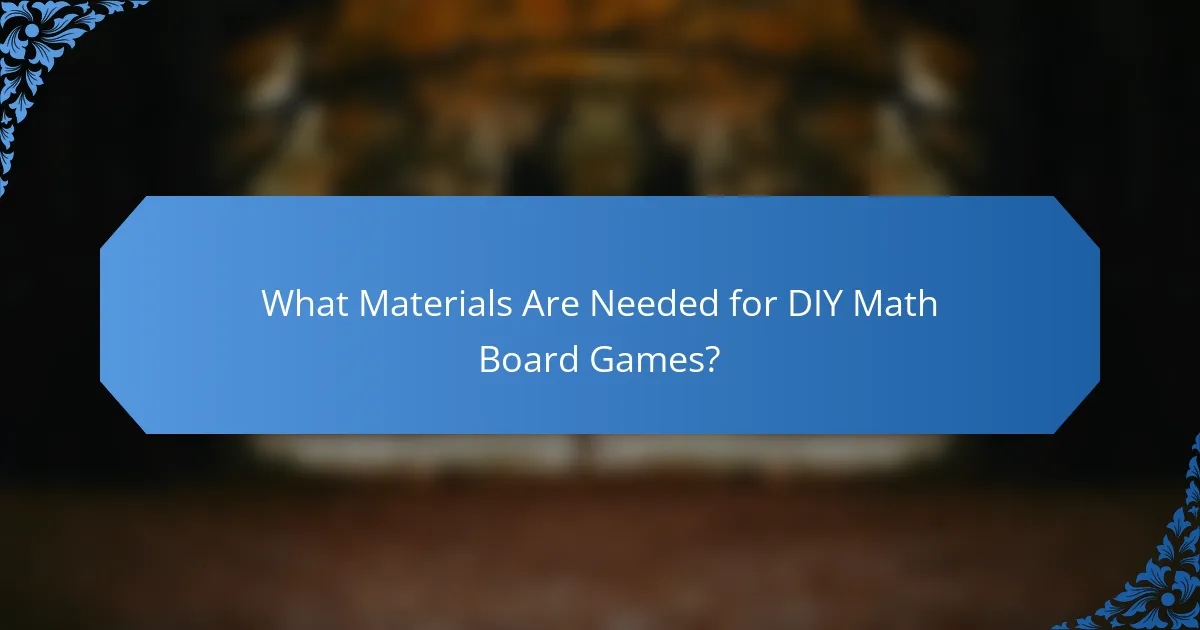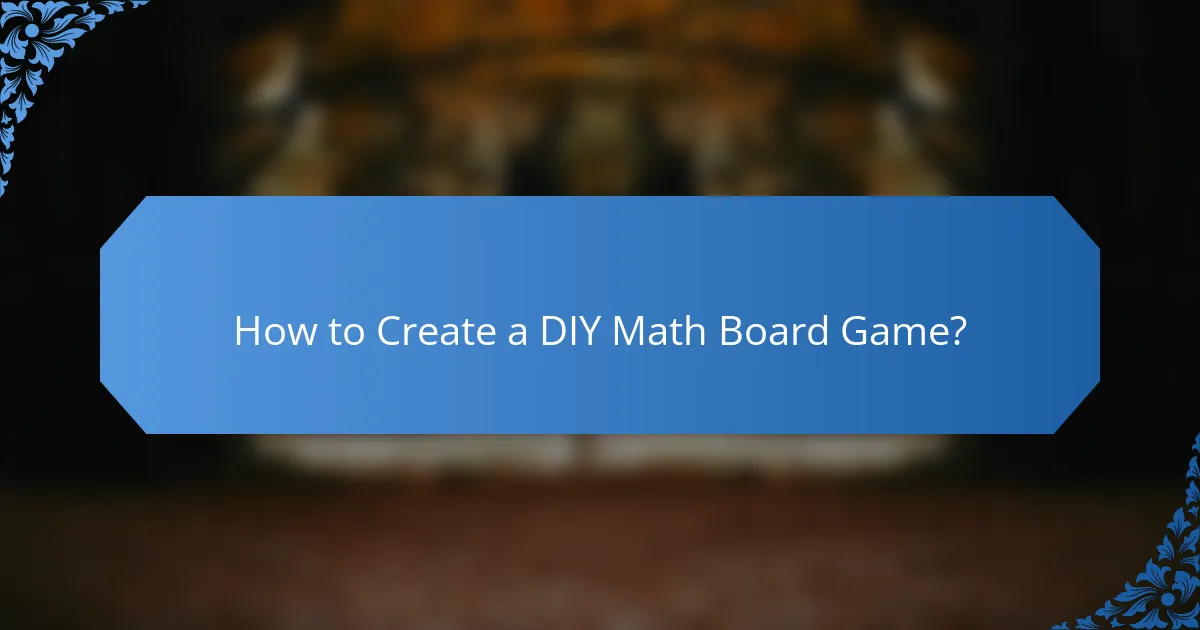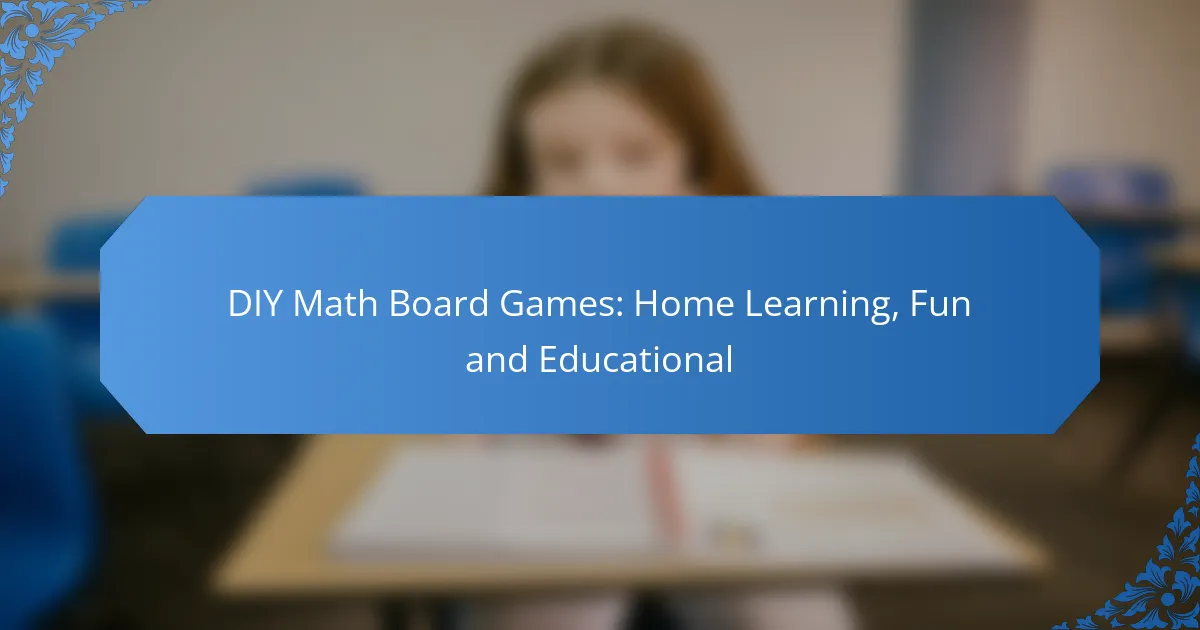DIY math board games offer a creative way to enhance home learning by transforming math concepts into engaging and interactive experiences. These games not only cultivate a love for learning but also provide practical applications of mathematical skills in a fun setting, making essential topics like arithmetic, fractions, and geometry more accessible and enjoyable for learners of all ages.

How Can DIY Math Board Games Enhance Home Learning?
DIY math board games can significantly enhance home learning by making math concepts engaging and interactive. These games not only foster a love for learning but also provide practical applications of mathematical skills in a fun environment.
Engagement through interactive play
Interactive play is a powerful tool for learning, as it keeps children actively involved in the learning process. DIY math board games encourage participation, making math less intimidating and more enjoyable. For instance, games that involve rolling dice or moving pieces can turn abstract concepts into tangible experiences.
To maximize engagement, consider incorporating themes or characters that resonate with your child’s interests. This approach can transform a simple math exercise into an exciting adventure, enhancing their motivation to learn.
Development of critical thinking skills
DIY math board games promote critical thinking by requiring players to strategize and solve problems. As children navigate challenges within the game, they learn to analyze situations, make decisions, and anticipate outcomes. This process builds essential skills that extend beyond math.
For example, a game that involves resource management can teach children how to prioritize tasks and allocate resources effectively. These skills are invaluable in both academic and real-world scenarios.
Customization for different learning levels
One of the key advantages of DIY math board games is the ability to customize them according to different learning levels. You can easily adjust the complexity of the game to suit your child’s current understanding of math concepts. This flexibility allows for gradual progression as their skills improve.
For younger children, focus on basic addition and subtraction, while older kids can tackle more complex operations like fractions or percentages. Tailoring the game ensures that it remains challenging yet achievable, keeping your child engaged.
Encouragement of family bonding
Playing DIY math board games as a family fosters bonding and creates shared experiences. These games provide an opportunity for parents and children to collaborate, communicate, and learn together, strengthening family relationships. The shared goal of winning or completing challenges can create a sense of teamwork.
Set aside regular game nights to make this a fun tradition. This not only enhances learning but also creates lasting memories that your family will cherish.
Integration of math concepts into daily life
DIY math board games can help integrate math concepts into everyday life, making learning relevant and practical. By using games that reflect real-life scenarios, children can see how math applies outside of the classroom. This connection reinforces their understanding and appreciation of the subject.
For example, a game that simulates shopping can teach budgeting and basic arithmetic in a relatable context. Encourage your child to think about math in their daily activities, such as cooking or planning outings, to further enhance their skills.

What Materials Are Needed for DIY Math Board Games?
To create engaging DIY math board games, you’ll need a variety of materials that are easily accessible and affordable. Essential supplies include cardboard, paper, markers, dice, and game pieces, along with printable templates to guide your design.
Cardboard and paper supplies
Cardboard and paper are the foundation of your DIY math board games. Use sturdy cardboard for the game board to ensure durability, while paper can be used for cards or scoring sheets. Consider using recycled materials to keep costs low and promote sustainability.
When cutting cardboard, aim for a size that fits comfortably on a table, typically around 24×24 inches. For paper components, standard letter size (8.5×11 inches) works well for cards and instructions.
Markers and coloring materials
Markers and coloring materials are vital for adding visual appeal to your game. Use a variety of colors to differentiate game elements, such as player pieces or scoring areas. Washable markers are a great choice, especially for younger children.
Consider including colored pencils or crayons for finer details and creativity. Encourage kids to personalize their games, which can enhance engagement and learning outcomes.
Dice and game pieces
Dice and game pieces are essential for gameplay mechanics. Standard six-sided dice are widely available and can be used for various math functions, such as addition or multiplication. You can also find specialty dice with different numbers of sides for more complex games.
For game pieces, use small items like buttons, coins, or even homemade tokens from cardboard. Ensure that each player has a distinct piece to avoid confusion during play.
Printable templates and resources
Printable templates and resources can simplify the creation of your math board games. Many websites offer free templates for game boards, cards, and instructions that you can customize to fit your educational goals.
Look for resources that align with specific math concepts, such as fractions or geometry. This targeted approach can make learning more effective and enjoyable for children.

Which Math Concepts Can Be Taught with Board Games?
Board games can effectively teach a variety of math concepts, making learning both engaging and interactive. Key areas include basic arithmetic, fractions, geometry, and probability, allowing players to practice skills in a fun environment.
Basic arithmetic operations
Basic arithmetic operations such as addition, subtraction, multiplication, and division can be easily integrated into board games. For instance, games that require players to collect points or resources often involve calculating totals or making change, reinforcing these fundamental skills.
To maximize learning, choose games that encourage frequent calculations and provide opportunities for players to practice mental math. Consider games like “Monopoly” or “The Game of Life,” which naturally incorporate arithmetic in their gameplay.
Fractions and decimals
Fractions and decimals can be taught through games that involve sharing resources or scoring systems. For example, a game that requires players to divide items among themselves can help illustrate the concept of fractions in a practical way.
Look for games that use scoring methods based on fractions or decimals, such as “Pizza Fraction Fun,” which allows players to visualize and manipulate fractions through pizza slices. This hands-on approach can enhance understanding and retention of these concepts.
Geometry and spatial reasoning
Geometry and spatial reasoning skills can be developed through games that involve shape recognition, area calculation, or spatial arrangement. Games like “Blokus” or “Tangrams” challenge players to think about shapes and their relationships, fostering geometric understanding.
Incorporating puzzles that require players to visualize and manipulate shapes can further enhance these skills. Encourage players to discuss their strategies and reasoning to deepen their comprehension of geometric concepts.
Probability and statistics
Probability and statistics can be effectively taught through games that involve chance, such as dice games or card games. These games allow players to explore outcomes and make predictions based on probabilities, helping them grasp these concepts in a practical context.
Consider games like “Risk” or “Catan,” where players must assess risks and make strategic decisions based on statistical outcomes. This not only makes learning engaging but also helps players develop critical thinking skills related to probability and data interpretation.

How to Create a DIY Math Board Game?
Creating a DIY math board game involves selecting a math concept, designing engaging mechanics, building a game board, and testing the final product. This hands-on approach not only makes learning fun but also reinforces mathematical skills through play.
Step 1: Choose a math concept
Selecting a math concept is the foundation of your board game. Focus on topics that are age-appropriate and relevant to the players, such as addition, subtraction, multiplication, or fractions. Consider integrating real-world applications to make the game more relatable.
For younger players, basic operations like addition and subtraction work well, while older children might enjoy more complex concepts like geometry or algebra. Aim for a concept that can be easily illustrated through gameplay.
Step 2: Design the game mechanics
Game mechanics dictate how players interact with the game and each other. Decide on the rules, objectives, and how players will progress through the game. Common mechanics include rolling dice, drawing cards, or answering questions to advance.
Incorporate elements that encourage critical thinking and problem-solving. For example, players could earn points for correctly answering math problems or face penalties for incorrect answers. Keep the rules simple to ensure that the game remains accessible.
Step 3: Create the game board
The game board should be visually appealing and clearly represent the game mechanics. Use materials like cardboard or poster board to create a sturdy base. Design a path that players will follow, incorporating spaces that relate to the chosen math concept.
Consider adding colorful illustrations or thematic elements to enhance engagement. You might include spaces that prompt players to solve math problems or collect rewards, making the board both functional and fun.
Step 4: Test and refine the game
Testing the game is crucial to ensure it is enjoyable and educational. Play the game with friends or family to gather feedback on the mechanics, rules, and overall experience. Observe how players interact and whether they grasp the math concepts effectively.
Be open to making adjustments based on feedback. This could involve simplifying rules, altering game mechanics, or even changing the math concept if necessary. The goal is to create a balanced game that is both fun and educational.

What Are Some Popular DIY Math Board Game Ideas?
DIY math board games combine learning with fun, making math concepts engaging for students. Popular ideas include Math Bingo and Fraction War, which can be easily created at home with minimal materials.
Math Bingo
Math Bingo is a classic game that reinforces arithmetic skills in a fun way. Players receive bingo cards filled with answers to math problems, while the caller reads out questions. When players solve a question, they mark the corresponding answer on their card.
To create your own Math Bingo, prepare a set of bingo cards with answers ranging from simple addition to more complex multiplication. You can use a standard 5×5 grid and fill it with answers to problems appropriate for the age group you are targeting. This game can be adapted for different skill levels by adjusting the difficulty of the math problems.
Be sure to have small tokens or markers for players to cover their answers, and consider offering small prizes for winners to increase motivation. Avoid using overly complex problems that might frustrate younger players.
Fraction War
Fraction War is a card game that helps players understand and compare fractions. The game is played with a standard deck of cards, where each card represents a fraction based on its value. Players draw cards and compare their fractions to see who has the larger one.
To set up Fraction War, assign values to the cards, such as 2 through 10 representing fractions like 2/10, 3/10, and so on. Players flip over their top card and the one with the larger fraction wins both cards. This game can be modified by using different sets of fractions, such as improper fractions or mixed numbers, to challenge players further.
Encourage players to explain their reasoning when determining which fraction is larger, as this reinforces their understanding. Avoid using face cards unless you assign them specific values, as this can confuse younger players.



